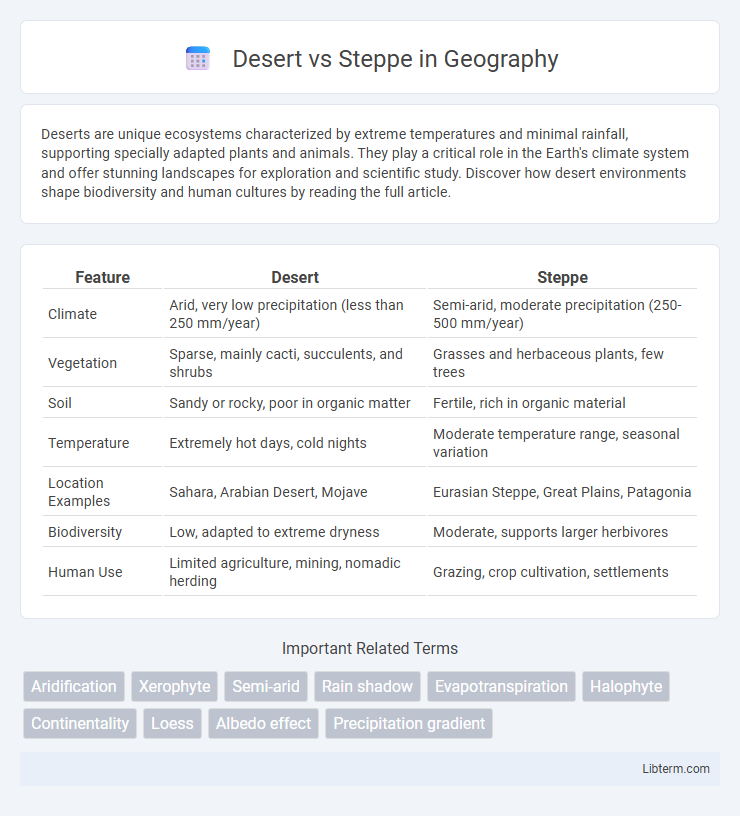Deserts are unique ecosystems characterized by extreme temperatures and minimal rainfall, supporting specially adapted plants and animals. They play a critical role in the Earth's climate system and offer stunning landscapes for exploration and scientific study. Discover how desert environments shape biodiversity and human cultures by reading the full article.
Table of Comparison
| Feature | Desert | Steppe |
|---|---|---|
| Climate | Arid, very low precipitation (less than 250 mm/year) | Semi-arid, moderate precipitation (250-500 mm/year) |
| Vegetation | Sparse, mainly cacti, succulents, and shrubs | Grasses and herbaceous plants, few trees |
| Soil | Sandy or rocky, poor in organic matter | Fertile, rich in organic material |
| Temperature | Extremely hot days, cold nights | Moderate temperature range, seasonal variation |
| Location Examples | Sahara, Arabian Desert, Mojave | Eurasian Steppe, Great Plains, Patagonia |
| Biodiversity | Low, adapted to extreme dryness | Moderate, supports larger herbivores |
| Human Use | Limited agriculture, mining, nomadic herding | Grazing, crop cultivation, settlements |
Introduction: Understanding Deserts and Steppes
Deserts and steppes are distinct biomes characterized by differences in climate, vegetation, and soil composition. Deserts typically receive less than 250 mm of annual precipitation, featuring sparse plant life adapted to extreme aridity, while steppes experience moderate rainfall between 250 and 500 mm, supporting grasses and shrubs. These variations influence biodiversity, land use, and ecosystem functions across arid and semi-arid regions worldwide.
Defining Deserts: Characteristics and Types
Deserts are arid regions characterized by extremely low precipitation, typically less than 250 millimeters annually, with sparse vegetation and extreme temperature variations between day and night. They are classified into hot deserts like the Sahara, characterized by high temperatures and sand dunes, and cold deserts such as the Gobi, marked by cold winters and sparse snowfall. The defining features of deserts include minimal cloud cover, high evaporation rates, and soil composed primarily of sand or rocky terrain with limited organic material.
Defining Steppes: Features and Classifications
Steppes are vast, treeless plains characterized by semi-arid climates that support grassland ecosystems with sparse shrubs and occasional drought-resistant trees. These regions experience moderate seasonal rainfall typically ranging from 250 to 500 millimeters annually, enabling the growth of hardy grasses adapted to dry conditions. Classified into temperate and sub-tropical steppes, these landscapes serve as transitional zones between deserts and forests, playing crucial roles in biodiversity and grazing agriculture.
Climate Differences: Hot, Dry vs. Cool, Semi-Arid
Deserts exhibit a hot, dry climate characterized by extremely low precipitation and high daytime temperatures, often exceeding 40degC, with minimal humidity and vast temperature fluctuations between day and night. Steppes experience a cool, semi-arid climate marked by moderate rainfall, usually between 250 and 500 mm annually, supporting grassland vegetation adapted to drier conditions with colder winters and milder summers. These climatic distinctions influence soil moisture, vegetation types, and biodiversity, delineating the ecological boundaries between desert and steppe biomes.
Soil Composition: Sand, Rock vs. Grassland Soils
Desert soil composition primarily consists of coarse sand, gravel, and exposed bedrock with minimal organic matter, resulting in low fertility and poor water retention. Steppe soils are characterized by nutrient-rich, fine-grained loams rich in organic material, supporting dense grassland vegetation. The difference in soil composition directly influences the distinctive ecosystems, with deserts having limited plant growth and steppes supporting vast expanses of grasses.
Biodiversity: Flora and Fauna Adaptations
Desert ecosystems exhibit extreme biodiversity adaptations, with flora like cacti and succulents evolving water-storing tissues and reduced leaf surfaces to minimize water loss, while fauna such as camels and fennec foxes demonstrate physiological and behavioral traits to survive scorching temperatures and scarce water. In contrast, steppe biomes support extensive grasslands dominated by drought-resistant grasses and herbaceous plants, providing habitat for grazing mammals like saiga antelopes and burrowing rodents, whose life cycles are adapted to seasonal variations and periodic droughts. Both biomes feature specialized biodiversity uniquely adapted to resource scarcity but differ in vegetation structure and animal survival strategies shaped by climate and soil conditions.
Geographic Distribution Worldwide
Deserts, characterized by extremely low precipitation, are predominantly found in regions such as the Sahara in Africa, the Arabian Desert in the Middle East, and the Mojave in North America. Steppes, defined by semi-arid grasslands, are most extensive in Central Asia, including the Eurasian Steppe spanning from Ukraine to Mongolia. The geographic distribution of deserts and steppes reflects variations in climate, altitude, and latitude, influencing their distinct ecosystems and vegetation patterns.
Human Interaction and Land Use
Deserts present harsh environments with limited water and vegetation, restricting extensive agriculture but supporting nomadic herding and sparse settlements adapted to arid conditions. Steppe regions, characterized by semi-arid grasslands, facilitate more diversified land use, including grazing livestock and cultivating drought-resistant crops due to relatively richer soils and seasonal precipitation. Human interaction in steppes often involves pastoralism and mixed farming, promoting sustainable exploitation of natural resources compared to the more fragile and conservative use patterns in deserts.
Environmental Challenges and Conservation
Deserts face extreme aridity and high temperatures, resulting in scarce water resources and fragile ecosystems vulnerable to erosion and desertification. Steppes, characterized by semi-arid climates and grassland vegetation, struggle with soil degradation, overgrazing, and habitat loss due to agricultural expansion. Conservation efforts in deserts prioritize water management and protecting endemic species, while steppe conservation focuses on sustainable grazing practices and preserving native grassland biodiversity.
Conclusion: Key Differences and Similarities
Deserts and steppes differ primarily in precipitation levels, with deserts receiving less than 250 mm annually, while steppes get between 250 and 500 mm, supporting more vegetation. Both biomes experience temperature extremes and feature sparse plant life adapted to arid conditions. Despite these similarities, deserts typically exhibit barren landscapes dominated by sand and rock, whereas steppes consist of vast grasslands with seasonal climate variations.
Desert Infographic

 libterm.com
libterm.com